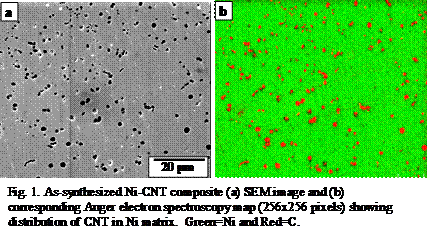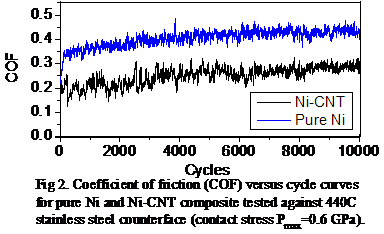Reports: G5
46915-G5 In Situ Chemical Diagnostic Tribology of Dry and Lubricated Thin Film-Based Technologies
This update focuses on further research efforts to monitor real time (in situ) wear, friction, and lubrication (tribology) of solid and self-lubricating films. Most of the research on tribological properties of carbon nanotube (CNT) composites has emphasized processing/property relationships, such as the role of processing parameters and volume percent of CNT in the matrix in achieving low friction and wear. While such studies are important for designing improved composites, both tribochemical and structural modification studies are needed to explain the friction and wear behavior. In particular, there is an obvious contradiction between the mechanical and tribological properties of metal-matrix composites reinforced with CNTs and the traditional model for a low-friction coating that associates low friction with low shear strength materials like graphite, not improved hardness materials like CNT-reinforced metals.
We have identified the role of third bodies in dictating the friction and wear behavior of laser engineered net shaping (LENS) deposited Ni-CNT composites. The approach was to determine if in situ formation of solid lubricating films in humid environments enhance the friction and wear behavior, and the feasibility to generate solid lubricants through microstructural control at the nanometer level. In addition, the presence of different active tribochemical phases present at the sliding interface in controlling the friction and wear behavior have been determined. Micro-Raman spectroscopy spatial chemical mapping was employed for site specific wear studies to elucidate the solid (self) lubrication mechanisms. If metal-CNT composites are to be utilized in moving mechanical assembly applications that involve sliding and/or rolling contacts, such as in oil drilling components, mechanistic studies are necessary to understand the role of tribochemistry (chemistry-induced by sliding) and structural evolution.
Figure 1 shows a representative SEM image in (a) and corresponding Auger electron spectroscopy (AES) map in (b) of the as-synthesized Ni-CNT composite. It is evident that the CNTs are well dispersed in the nickel matrix with a bundle size ranging from ~1 to 3 mm. The high shear stresses during ball milling cause disintegration of CNTs into smaller bundles that physically adhere to the surface of nickel powder particles. This coupled with the instantaneous melting and deposition of the nickel powders results in a homogeneous distribution of CNT bundles within the nickel matrix. The homogeneous distribution and reasonably refined near-spherical carbon-rich regions inside the nickel matrix are clear evidence of the advantage of dry uniform mixing via ball milling, overcoming the limitations associated with the density difference between nickel and CNT powders.
Figure 2 shows the results of the tribometry (friction) studies carried out on the LENS deposited Ni-CNT composite. Representative coefficient of friction (COF) versus number of cycles have been plotted for a Ni-CNT composite as well as a pure Ni specimen as a reference. It is clear that the CNTs in the composite were beneficial in reducing the COF with respect to the pure Ni reference sample for the entire 10,000 cycles. Therefore, this COF reduction of ~ 0.17 against 440C SS can be attributed to the presence of the CNTs. The specific wear mechanism, e.g. metal oxidative wear, abrasive and/or adhesive wear, can not be ascribed without examining the structural modification and tribochemical film formation inside the wear tracks. Much of the current literature speculates on their role in controlling the friction and wear processes of metal-CNT composites, and this is the subject of the below paragraph.
Raman spectroscopy mapping was performed inside the wear tracks to elucidate the mechanisms responsible for the solid lubrication processes. Figure 3 shows Raman spectroscopy color maps overlaid on the optical microscopy images recorded inside the wear tracks after the test shown in Figure 2 was completed at 10,000 cycles. These blended images of the optical micrograph and Raman intensity map allow for accurate analysis of what tribochemical products may have formed inside the wear tracks. The blended image shown in Figure 3(a) for pure Ni was generated by selecting the Raman peak at 553 cm-1 inside the wear track which is NiO. This suggests that the pure Ni sample exhibited oxidative wear, or tribo-oxidation, since NiO was present throughout the wear track (representative location shown by red circle in Figure 3(a)), and not present outside the wear track (representative location shown by blue circle and spectrum in Figures 3(a) and 3(b), respectively).
The Raman spectroscopy color map and spectra of the counterface sliding against Ni-CNT composite are shown in Figures 3(c) and 3(d), respectively. The highest intensity (concentration) of tribochemical species inside the wear track are ascribed to the carbon D (1345 cm-1) and G (1604 cm-1) peaks, e.g., representative location shown by red circle in Figure 3(c). Compared to the G peak at 1582 cm-1 for the unworn Ni-CNT composite (representative location shown by blue circle and spectrum in Figures 3(c) and 3(d), respectively), the G peak shifted 22 cm-1 towards higher wave number, the ID/IG ratio and FWHM of the D and G peaks increased, which all indicate increased structural disorder due to the sliding wear process. In addition, there is either no NiO or a minimal amount (intensity) in the wear track, not shown, that also scaled with the wear-induced changes in the graphitic peaks. The wear-induced graphitic film is prevalent across the entire wear track as shown in Figure 3(c). This indicates that there is a protective role of the graphitic film on the wear track because oxygen would react with the carbon first instead of the nickel matrix because carbon is easier to oxidize than nickel and thus impede NiO formation. As a result, the graphitic film not only provides solid lubrication during sliding, but also prevents the nickel from oxidation. The counterface also showed transfer film formation (adhesive wear) with identical Raman D and G peak graphitization parameters as observed within the wear track. This in situ formed, self-mated graphitic film resulted in lower interfacial shear strength, which accounted for the decrease in the friction coefficient for the Ni-CNT composite as compared to pure Ni that oxidized.







